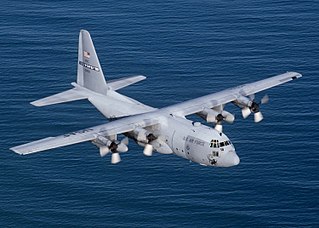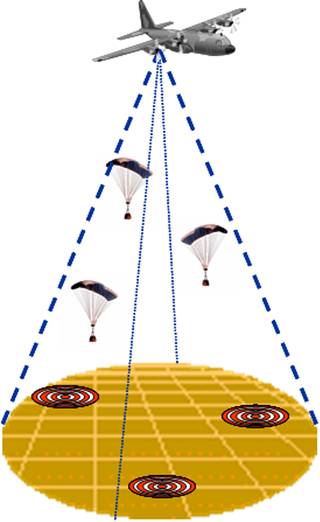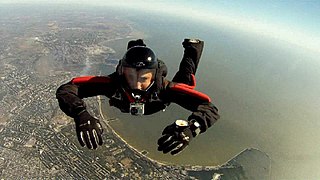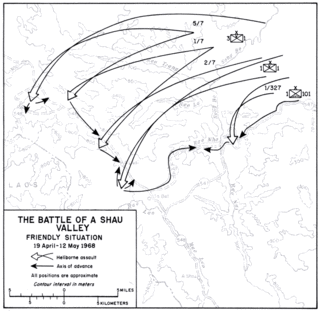
The Lockheed C-130 Hercules is an American four-engine turboprop military transport aircraft designed and built by Lockheed. Capable of using unprepared runways for takeoffs and landings, the C-130 was originally designed as a troop, medevac, and cargo transport aircraft. The versatile airframe has found uses in other roles, including as a gunship (AC-130), for airborne assault, search and rescue, scientific research support, weather reconnaissance, aerial refueling, maritime patrol, and aerial firefighting. It is now the main tactical airlifter for many military forces worldwide. More than 40 variants of the Hercules, including civilian versions marketed as the Lockheed L-100, operate in more than 60 nations.

A parachute is a device used to slow the motion of an object through an atmosphere by creating drag or, in a ram-air parachute, aerodynamic lift. A major application is to support people, for recreation or as a safety device for aviators, who can exit from an aircraft at height and descend safely to earth.

The Battle of Khe Sanh was conducted in the Khe Sanh area of northwestern Quảng Trị Province, Republic of Vietnam, during the Vietnam War. The main US forces defending Khe Sanh Combat Base (KSCB) were two regiments of the United States Marine Corps supported by elements from the United States Army and the United States Air Force (USAF), as well as a small number of Army of the Republic of Vietnam (ARVN) troops. These were pitted against two to three divisional-size elements of the North Vietnamese People's Army of Vietnam (PAVN).

In aircraft, an ejection seat or ejector seat is a system designed to rescue the pilot or other crew of an aircraft in an emergency. In most designs, the seat is propelled out of the aircraft by an explosive charge or rocket motor, carrying the pilot with it. The concept of an ejectable escape crew capsule has also been tried. Once clear of the aircraft, the ejection seat deploys a parachute. Ejection seats are common on certain types of military aircraft.

A drogue parachute is a parachute designed for deployment from a rapidly-moving object. It can be used for various purposes, such as to decrease speed, to provide control and stability, or as a pilot parachute to deploy a larger parachute. Vehicles that have used drogue parachutes include multi-stage parachutes, aircraft, and spacecraft recovery systems.

A loadmaster is an aircrew member on civilian aircraft or military transport aircraft tasked with the safe loading, transport and unloading of aerial cargoes. Loadmasters serve in the militaries and civilian airlines of many nations.

An airdrop is a type of airlift in which items including weapons, equipment, humanitarian aid or leaflets are delivered by military or civilian aircraft without their landing. Developed during World War II to resupply otherwise inaccessible troops, themselves often airborne forces, airdrops can also refer to the airborne assault itself.

In skydiving, an automatic activation device (AAD) is a dead man's switch consisting of an electronic-pyrotechnic or mechanical device that automatically opens the main or reserve parachute container at a preset altitude or after a preset time.

The Shaanxi Y-8 or Yunshuji-8 aircraft is a medium size medium range transport aircraft produced by Shaanxi Aircraft Corporation in China, based on the Soviet Antonov An-12. It has become one of China's most popular military and civilian transport/cargo aircraft, with many variants produced and exported. Although the An-12 is no longer made in Ukraine, the Chinese Y-8 continues to be upgraded and produced. An estimated 169 Y-8 aircraft had been built by 2010.

A static line is a fixed cord attached to a large, stable object. It is used to open parachutes automatically for paratroopers and novice parachutists.

Glider infantry was a type of airborne infantry in which soldiers and their equipment were inserted into enemy-controlled territory via military glider. Initially developed in the late 1930s by Germany, glider infantry units were used extensively during World War II but are no longer used by any modern military.
A parachute rigger is a person who is trained or licensed to pack, maintain or repair parachutes. A rigger is required to understand fabrics, hardware, webbing, regulations, sewing, packing, and other aspects related to the building, packing, repair, and maintenance of parachutes.

The Joint Precision Airdrop System (JPADS) is an American military airdrop system which uses the Global Positioning System (GPS), steerable parachutes, and an onboard computer to steer loads to a designated point of impact (PI) on a drop zone (DZ). The JPADS family of systems consists of several precision airdrop systems, ranging from extra light to heavy payloads. JPADS is used in conjunction with mission planning software that resides on a laptop. The function of this mission planning software includes computing release points, weather forecasting, acquiring measurements of wind velocity, altitude, air pressure, and temperature. It can also receive weather updates and en route mission changes through satellite links.

The 834th Airlift Division is an inactive United States Air Force organization. Its last assignment was with Military Airlift Command, assigned to Twenty-Second Air Force at Hickam Air Force Base, Hawaii, where it was inactivated on 1 April 1992.

Parachuting, including also skydiving, is a method of transiting from a high point in the atmosphere to the surface of Earth with the aid of gravity, involving the control of speed during the descent using a parachute or parachutes.

Operation Delaware/Operation Lam Son 216 was a joint military operation launched during the Vietnam War. It began on 19 April 1968, with troops from the United States and the Army of the Republic of Vietnam (ARVN) moving into the A Sầu Valley. The A Sầu Valley was a vital corridor for moving military supplies coming from the Ho Chi Minh Trail and was used by the People's Army of Vietnam (PAVN) as a staging area for numerous attacks in northern I Corps. Other than small, special operations reconnaissance patrols, American and South Vietnamese forces had not been present in the region since the Battle of A Shau in March 1966, when a U.S. Special Forces camp located there was overrun.

Ground Parachute Extraction System (GPES) refers to a method by which ground forces are resupplied by low altitude air drops. It has also been referred to as Ground Proximity Extraction System. The system, developed jointly by the United States Air Force and Army, is similar to the arrester technique used on aircraft carriers. The cargo aircraft flies low over the delivery area. A hook is attached to the pallet load. Another hook at the other end of the cable line is attached to the rear cargo door. When the plane nears the delivery site, the hook at the cargo door snags an arrester wire that is placed perpendicular to the plane's flight path thereby yanking the pallet load out of the aircraft to the intended delivery site.

A drop test is a method of testing the in-flight characteristics of prototype or experimental aircraft and spacecraft by raising the test vehicle to a specific altitude and then releasing it. Test flights involving powered aircraft, particularly rocket-powered aircraft, may be referred to as drop launches due to the launch of the aircraft's rockets after release from its carrier aircraft.

Rapid Dragon is a palletized and disposable weapons module which is airdropped in order to deploy flying munitions, typically cruise missiles, from unmodified cargo planes. Developed by the United States Air Force and Lockheed, the airdrop-rigged pallets, called "deployment boxes," provide a low cost method allowing unmodified cargo planes, such as C-130 or C-17 aircraft, to be temporarily repurposed as standoff bombers capable of mass launching any variant of long or short range AGM-158 JASSM cruise missiles against land or naval targets.




















